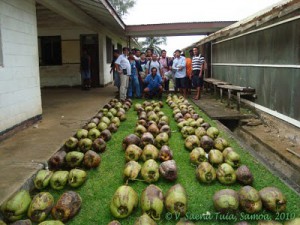- Rethinking peanut genetic diversity. All you need is a new marker.
- Saving the English hay meadow. Hey, there’s a few crop wild relatives in there, apart from anything else!
- 30,000 year-old fibres not flax after all?
- Today’s modifier for “Green Revolution” is “old-fashioned.”
- Maize evolution is a tale of chromosome doubling and subsequent divergence of the two sets.
Nibbles: Allium, Desertification and livestock, Striga, Emmer, Hawaii, Almond, Seeds at FAO, Cassava in central Africa, Seed sculpture, Biofortification, Millets, Lunatrick pea
- Botany Photo of the Day is an onion wild relative! Pretty.
- More on that livestock-can-help-reduce-desertification thing, this time from Scientific American.
- Breeding Striga-resistant sorghum. Whatever it takes to protect local beer, boffin-dudes!
- Emmer wheat reviewed to bits.
- No passport data for your barley? Fear not.
- Rachel Laudan ably defends Hawaiian food.
- Origins of almond traced to Iran. Not for the first time.
- Plant Genetic Resources for Food and Agriculture: A Commons Perspective. Presentation from our friends at FAO.
- Presentation on the untapped potential of cassava in the Great Lakes region of Africa. One of many from CIAT lately. Check out their stuff on beans too.
- The Seed Cathedral of Shanghai. Thanks to those public awareness wizards at Kew.
- Big shindig on biofortification. Be there, or be malnourished.
- Times of India bangs the drum for nutritious millets.
- Yet more loveliness from serious amateur pea breeder Rebsie Fairholm.
Nibbles: Sugarcane breeding, Caterpillar mushroom, Saharan honeybees, Vodka taste, Cotton genetic resources, African savannah ag, Organic videos
- Fiji looking for better sugarcane. Not a moment too soon, with the EU subsidies going and all.
- Collecting the very valuable caterpillar mushroom in China’s protected areas. Illegal, but whachagonnado?
- The honeybees of the Saharan oases are isolated. Well, actually, not all of them, which I guess qualifies as a surprise.
- Can you tell different vodka brands apart? Here’s why. Maybe. Sounds a bit flaky to me.
- A global review of cotton genetic resources.
- Ploughing up the African savannah is gonna solve all our problems, apparently.
- Organic Seed Alliance launches a youtube channel. Oh goody, there’s how to breed organic carrots!
Looking for Niu Afa
You have been following the Adventures of Roland in Samoa, have you not?

Nibbles: Roses, Stripe Rust, Cuba, Carnival, India, GCARD, Urban ag, Genetic diversity and herbivory, Biocultural diversity
- The wages of Kenyan rose growers increase 22% — to $59 a month. Sinful.
- Wheat stripe rust uses sex to break down barriers.
- Q&A with Cuban whiz Humberto Ríos.
- Latest Carnival of Evolution is up; we’re the only ag, alas.
- Proposed agricultural biodiversity heritage sites in India. (Is this new?)
- Investing in Underutilised Crops to Achieve Food Security. A report from the CGARD conference in March.
- The Hanging Gardens of Kenya.
- Living in genetic mixtures helps plants against herbivores. No, really.
- “Restoring human cultures to the web of life.”